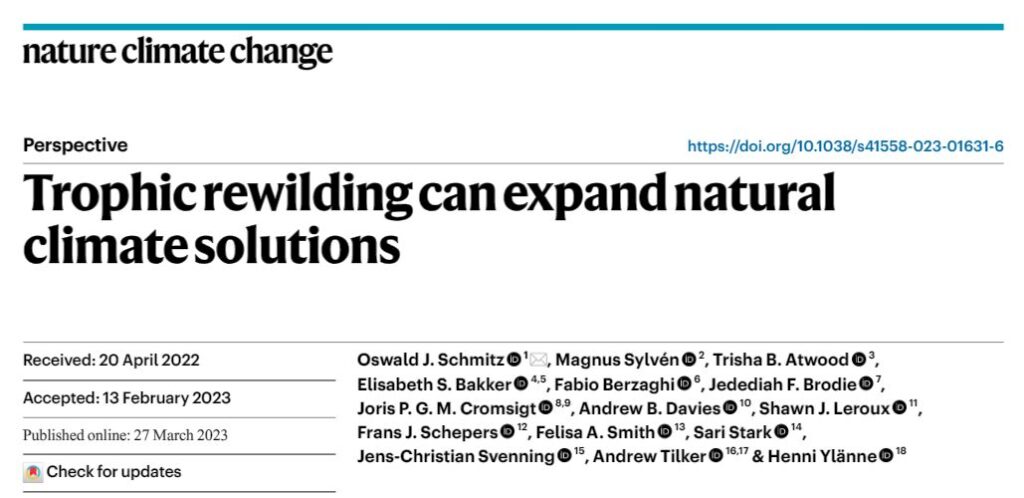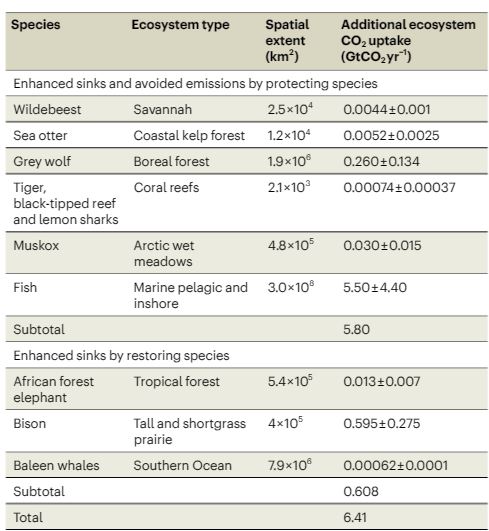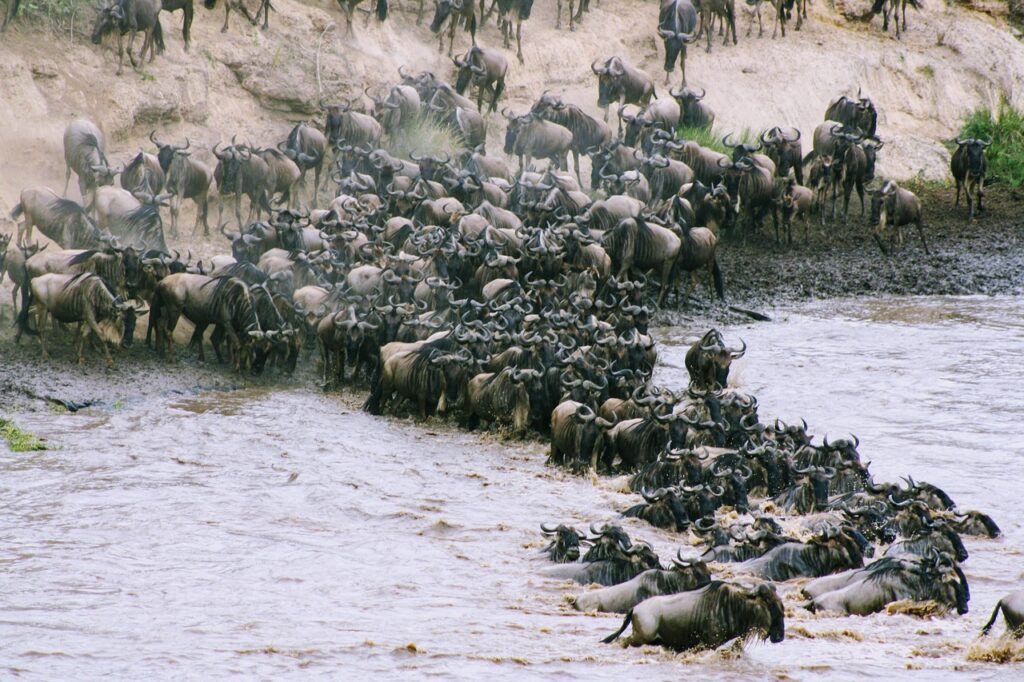The study titled “Trophic Rewilding Can Expand Natural Climate Solutions” offers groundbreaking insights into how restoring populations of key species, such as wildebeest, can become a potent and natural solution to combat global warming. This comprehensive research illustrates that the behavior of large herbivores like the wildebeest in ecosystems significantly influences carbon storage, vegetation management, and climate regulation.

climate solutions
Key Concepts: Trophic Rewilding and Its Role in Climate Solutions
Trophic rewilding refers to the restoration of species that play critical roles in food webs and ecosystems, with the aim of promoting ecological functions that contribute to climate regulation. In the case of the Serengeti wildebeest, rewilding efforts and population recovery after historical declines have helped reshape the landscape’s ability to store carbon and mitigate wildfires.
The study reveals that rewilding large herbivores, such as wildebeest, can restore natural processes that prevent the over-accumulation of vegetation, which otherwise serves as fuel for wildfires. These fires release large amounts of carbon stored in plants and soil, transforming a region from a carbon sink to a carbon source. By preventing such fires, wildebeest and other species can maintain and enhance carbon sequestration across vast landscapes.
Estimated Animal Effects on Net Ecosystem Carbon Storage and the Spatial Extent of Ecosystems in which the Animals Occur
| Species | Ecosystem type | Spatial extent (km²) | Additional ecosystem CO₂ uptake (GtCO₂ yr−1) |
|---|---|---|---|
| Wildebeest | Savannah | 2.5 × 10⁴ | 0.0044 ± 0.001 |
| Sea otter | Coastal kelp forest | 1.2 × 10⁴ | 0.0052 ± 0.0025 |
| Grey wolf | Boreal forest | 1.9 × 10⁶ | 0.260 ± 0.134 |
| Tiger, black-tipped reef and lemon sharks | Coral reefs | 2.1 × 10³ | 0.00074 ± 0.00037 |
| Muskox | Arctic wet meadows | 4.8 × 10⁵ | 0.030 ± 0.015 |
| Fish | Marine pelagic and inshore | 3.0 × 10⁸ | 5.50 ± 4.40 |
| Subtotal | 5.80 | ||
| African forest elephant | Tropical forest | 5.4 × 10⁵ | 0.013 ± 0.007 |
| Bison | Tall and shortgrass prairie | 4 × 10⁵ | 0.595 ± 0.275 |
| Baleen whales | Southern Ocean | 7.9 × 10⁶ | 0.00062 ± 0.0001 |
| Enhanced sinks by restoring species | 0.608 | ||
| Total: 6.41 |
This table outlines the estimated carbon storage effects of various species and the spatial extent of ecosystems where they occur. Let me know if you need further adjustments!

storage and the spatial extent of ecosystems in which the
animals occur
The Impact of Wildebeest Grazing on Carbon Sequestration
One of the study’s most significant findings is that for every 100,000 additional wildebeest in the Serengeti, the amount of carbon stored in the ecosystem increases by 15%. This demonstrates the immense potential of wildebeest populations to influence carbon dynamics by:
- Reducing Fuel for Wildfires: The grazing behavior of wildebeest prevents the buildup of dry grasses and vegetation that contribute to frequent and intense wildfires. Without these animals, the Serengeti experienced more regular wildfires, which released substantial amounts of carbon into the atmosphere.
- Enriching the Soil: As wildebeest graze, their dung naturally fertilizes the soil, increasing its nutrient content and its ability to sequester carbon. Their hooves also break up the soil, encouraging plant growth and further locking carbon into the ecosystem.
- Promoting a Healthy Savannah Ecosystem: Wildebeest influence the balance between grasslands and woody vegetation through their grazing and other behaviors. Male wildebeest engage in “horning” – rubbing their horns against trees and shrubs, which helps to thin out woody vegetation and maintain the savannah landscape. A healthy savannah can store more carbon than densely wooded or fire-prone regions.
Historical Context: How Population Declines Affected the Serengeti’s Carbon Cycle
The study also underscores the historical significance of wildebeest population changes in the 20th century. During the early 1900s, the Serengeti’s wildebeest herds were decimated due to outbreaks of the viral disease rinderpest, which spread from cattle. By the 1950s, the population had dropped to approximately 240,000, a fraction of today’s 1.2 million. This drastic reduction led to an overgrowth of vegetation, fueling widespread wildfires that transformed the Serengeti into a net carbon source.
In the 1950s, the successful implementation of a cattle vaccination program allowed wildebeest populations to rebound. By the 1970s, the Serengeti’s wildebeest population peaked at 1.5 million, and the region shifted back into a carbon sink. This demonstrates the clear connection between healthy wildebeest populations and climate stabilization through carbon storage.
Key Stats From the Study:
- 1.2 million wildebeest currently roam the Serengeti, contributing to the ecosystem’s carbon storage capabilities.
- The study estimates that the presence of every 100,000 wildebeest boosts carbon sequestration by 15%.
- The researchers calculate that restoring large herbivore populations globally could facilitate the capture of 6.41 billion tonnes of CO₂ annually. This figure represents nearly two-thirds of the total CO₂ reduction required globally to meet climate goals by 2050.
Global Rewilding Potential: How Herbivores Contribute to Natural Climate Solutions
The research outlined in the study emphasizes that wildebeest are not unique in their potential to mitigate climate change. Similar benefits can be achieved by restoring populations of other large herbivores, predators, and keystone species in ecosystems across the globe. This includes species like African elephants, musk oxen in the Arctic, and grey wolves in North America, each of which plays a critical role in maintaining vegetation dynamics and carbon storage.
The researchers argue that rewilding these animals and integrating wildlife conservation with climate strategies offers a largely untapped natural climate solution. The 6.41 billion tonnes of CO₂ that could be captured annually through rewilding represent a significant fraction of the 10 billion tonnes of CO₂ that scientists estimate must be removed annually to meet net-zero emissions targets by 2050.
The Role of Wildebeest in Global Climate Strategy
While technological advancements such as carbon capture technologies and renewable energy systems are essential to tackling global warming, the study suggests that natural climate solutions through trophic rewilding are equally vital. By maintaining and expanding wildebeest populations in the Serengeti, we can:
- Protect the ecosystem from becoming a carbon source.
- Stabilize carbon storage in both the soil and vegetation.
- Maintain the balance between grasslands and woody vegetation to support biodiversity and prevent fire outbreaks.
Conclusion: Wildebeest as Carbon Stewards
The study “Trophic Rewilding Can Expand Natural Climate Solutions” makes a compelling case for the critical role of wildebeest and other large herbivores in addressing climate change. By restoring and protecting these species, we can harness the natural processes they promote, such as controlling vegetation and preventing fires, to expand the carbon storage capacity of ecosystems like the Serengeti.
These findings underscore the importance of integrating conservation efforts with global climate strategies, offering a powerful and cost-effective solution to reverse global warming trends. Wildebeest, and other species like them, may very well be one of nature’s secret weapons in the fight against climate change.
Key Takeaways:
- Wildebeest help sequester carbon by reducing fire-prone vegetation and enriching soil.
- Restoring animal populations like wildebeest could capture 6.41 billion tonnes of CO₂ annually.
- The rewilding of species offers a cost-effective, natural solution to complement technological efforts in mitigating global warming.
This expert analysis of the original study highlights how conservation through rewilding can serve as a crucial component of natural climate solutions in the face of global climate challenges.

